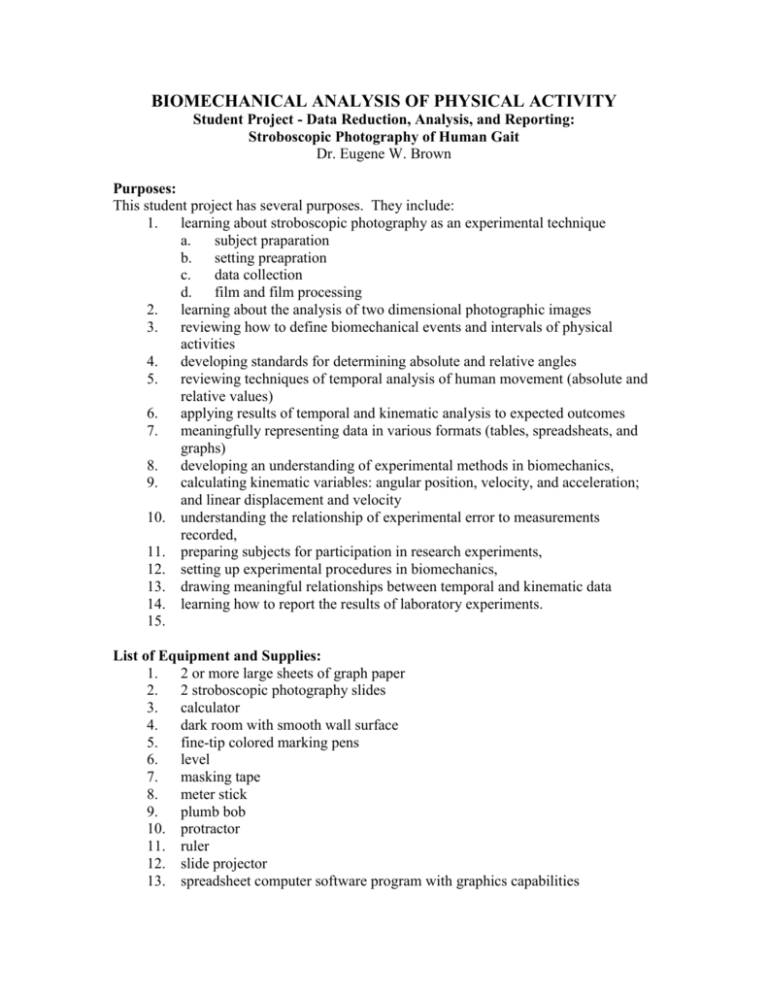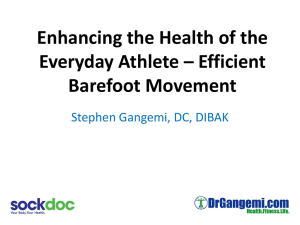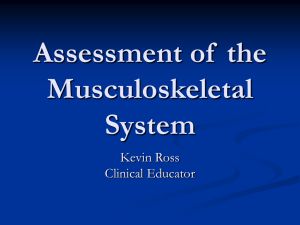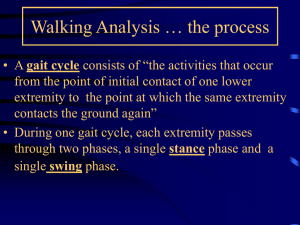Stroboscopic photography lab
advertisement

BIOMECHANICAL ANALYSIS OF PHYSICAL ACTIVITY Student Project - Data Reduction, Analysis, and Reporting: Stroboscopic Photography of Human Gait Dr. Eugene W. Brown Purposes: This student project has several purposes. They include: 1. learning about stroboscopic photography as an experimental technique a. subject praparation b. setting preapration c. data collection d. film and film processing 2. learning about the analysis of two dimensional photographic images 3. reviewing how to define biomechanical events and intervals of physical activities 4. developing standards for determining absolute and relative angles 5. reviewing techniques of temporal analysis of human movement (absolute and relative values) 6. applying results of temporal and kinematic analysis to expected outcomes 7. meaningfully representing data in various formats (tables, spreadsheats, and graphs) 8. developing an understanding of experimental methods in biomechanics, 9. calculating kinematic variables: angular position, velocity, and acceleration; and linear displacement and velocity 10. understanding the relationship of experimental error to measurements recorded, 11. preparing subjects for participation in research experiments, 12. setting up experimental procedures in biomechanics, 13. drawing meaningful relationships between temporal and kinematic data 14. learning how to report the results of laboratory experiments. 15. List of Equipment and Supplies: 1. 2 or more large sheets of graph paper 2. 2 stroboscopic photography slides 3. calculator 4. dark room with smooth wall surface 5. fine-tip colored marking pens 6. level 7. masking tape 8. meter stick 9. plumb bob 10. protractor 11. ruler 12. slide projector 13. spreadsheet computer software program with graphics capabilities Definition of Terms: 1. absolute angle - angular position; orientation in a global or laboratory reference system 2. activity plane – primary plane of movement; usually two dimensional plane that best represents movement being studied (e.g., sagittal plane for standard gait patterns, frontal plane for jumping jack exercises) 3. amplitude – difference between minimum and maximum angle 4. angular acceleration ()– change in angular velocity/change in time; slope of the tangent to the angular velocity curve; units of deg. s-2 or rad. s-2 5. angular position – absolute angle; orientation in a global or laboratory reference system 6. angular velocity () – change in angular position or relative angle/change in time; units of deg. sec-1 or rad. s-1 7. data sample rate – see flash rate (Note that the data sample rate should be at least two times the expected frequency of the signal.) 8. events – definable actions that occur in a brief moment of time (e.g., heel contact with the ground, toe off the ground) 9. fiducial – two or more marks placed in the field of view of a video or motion picture camera (usually at the outer edges of the field of view) to be used to align sequential images to a laboratory coordinate system 10. flash rate – the number of short duration high intensity light flashes from a strobe light per minute (e.g., 900 flashes/minute, 1200 flashes/minute) 11. functional range of movement – minimum to maximum angle of a joint in the performance of a physical activity 12. instantaneous center of rotation – joint center of rotation at a given point in time 23. intervals – phases; definable periods of time that start and end with definable events (e.g., support phase defined from foot contact with the ground to foot off the ground) 14. joint axis of rotation – center of rotation of two segments composing a joint determined by their relative motion 15. metronome – device that provides a repetitive auditory and/or electronic signals equally spaced in time (Note that the frequency of most metronomes can be adjusted.) 16. optic axis of lens – line through the center of the lens of the 35 mm camera that was perpendicular to the activity plane or line through the center of the lens of the slide projector that was perpendicular to the graph paper screen surface 17. perspective error – error which occurs when parts of a body or implement lie outside the principle photographic plane; image of segment closer to the camera appears larger and segment farther away appears smaller 18. plumb bob – weighted line that hangs vertical and is used for spatial orientation 19. range of movement (ROM) – minimum to maximum angle that can be achieved at a joint 20. reference measure – an object of known length (e.g., meter stick) that is 21. 22. 23. 24. 25. 26. 27. 28. 29. placed in a plane that is perpendicular to the optic axis of the lens of a camera that is used to assist in determining distance measurements in the same plane relative angle – orientation of one segment with respect to another relative joint angle – the angle formed by lines representing two segments with respect to each other standard walking frequency – 120 steps per minute; rate often used in experimental analyses of walking gait patterns in subjects free of any handicapping conditions step – in a gait pattern, from heel strike of one foot to the next heel strike of the opposite foot stride – in a gait pattern, from heel strike of one foot to the next heel strike of the same foot subject identification number – alpha and/or numeric value used to differentiate and identify subjects; code placed in the field of view of a camera that is used to distinguish each subject temporal analysis – report and comparison of when (time) defined events occur and the interval of time between defined events a. absolute temporal analysis – uses actual times and time intervals b. relative temporal analysis – divides time values by some standard (e.g., total time for the completion of a cycle) and reports them as a decimal value (Note that this is a normalizing process that permits the comparison of time intervals that compose performances of different total times.) trial number – alpha and/or numeric value used to differentiate among trials of a subject; code placed in the field of view of a camera that is used to distinguish individual performances of each subject walkway – narrow mat used to assist subjects in maintaining their movement pattern in a constricted plane; also used to minimize perspective error in two dimensional photography of primarily planar movements Premise: The Shifty Shoe Company has been doing stroboscopic studies of the gait patterns of subjects wearing its new experimental model shoes to get a “leg up” on its competition. Recently, it has run into some difficulty. Its chief research biomechanist has defected to a competing company. The Shifty Shoe Company managed to retain the stroboscopic photography negatives of the gait patterns of subjects wearing its new experimental models and has the details of the Experimental Methods used to produce these negatives. You have been hired to complete one comparison study. Your responsibility is to produce information requested by the Shifty Shoe Company and to respond to questions about the performance of gait patterns under the conditions represented in the two negatives that you have received. Experimental Methods: Subject Preparation One adult female subject (55.79 kg, 170 cm, 26 years of age) was used for all gait conditions studied. In some of the experiments, the pace of the metronome was adjusted (slow, fast) to achieve two separate gait speeds. The setting of the metronome is not currently known. Prior to data collection, she received practice walking, to the regular beat of a metronome, in each of the experimental shoes. For data collection, she was dressed in black leotards. Prior to donning the leotards, a system of tacks projecting through moleskin patches was used to mark joint centers of the right ankle, knee, hip, shoulder, elbow, and wrist. The leotards were stretched over the joint markers that were adhered to the subject’s skin via the moleskin patches. 3M Company reflective tape was adhered to the exterior of the leotard to designate the joint centers that were established by the tacks. Large shapes (e.g., triangles, arrows. diamonds,) were cut out of the reflective tape and the points of these shapes were positioned at the point of the center of the tack. In addition, narrow lines were cut out of the reflective tape and adhered to the exterior of the leotard to connect the joint center markers. Setting Preparation A thin black vinyl walkway mat was placed on the wood floor surface of the gait laboratory. This mat was narrow and guided the subject in a narrow activity plane in an attempt to reduce perspective error associated with two dimensional photography. The background was a matte black color so that it would reflect a minimum amount of light back to the 35mm camera. The camera was positioned 6.1 meters from the right side of the subject. At this distance, the use of a 55mm focal length lens resulted in the maximization of subject’s size, for the completion of two steps, in the field of view. The camera’s optic axis was aligned perpendicular to the plane of movement formed by the right side of the subject. The optic axis of the lens of the camera was at a height of 1 meter off the ground. The camera was leveled in this position. A plumb line, and subject identification and trial numbers were hung in the field of view of the camera. A General Radio strobolume set at the high intensity output was position just outside the field of view of the camera at 5.64 meters from the right side of the subject. The frequency of the strobolume was established by the strobotac. Data Collection Data was collected in a darkened room. The perimeters of the camera’s field of view were marked on the walkway. The only light sources in the room during data collection were the General Radio strobotac and strobolume. These strobe lights were turned on prior to the subject’s initiation of her walking pattern. The metronome was subsequently turned on and the subject imitated its frequency with her step rate. Immediately after the subject entered the field of view, the shutter of the camera was opened and left open until the subject exited the field of view. Film and Film Processing High speed 400 ASA black and white print film was used for the stroboscopic photography pictures. The film was push-processed with Acufine developer to create an ASA of 1000. Based on the General Radio instruction manual the guide number was determined to be 200. This resulted in a calculated f-stop of 11 for the camera. After the film was processed, the individual negatives were put in slide mounting jackets. Stroboscopic Photography Negative Records of Walking Patterns: Slide Numbers and/or Subject and Trial Numbers Corresponding Descriptions of the 2 Comparison Slide Negatives 1/13 slow, bare feet/slow, high heels fast, bare feet/fast, high heels fast, bare feet/fast, high heels slow sneakers/slow, hiking boots slow, sneakers/slow, hiking boots fast, sneakers/fast, hiking boots fast, sneakers/fast, hiking boots slow, clogs/fast, clogs 3/15 4/16 9/17 10/18 11/19 12/20 5/7 Stroboscopic Photography Flash Rate (f./min.) 1200 1200 900 1200 900 1200 900 1200 6/8 slow, clogs/fast, clogs 900 21/23 slow, orthopedic/fast, orthopedic slow, orthopedic/fast, orthopedic 1200 22/24 900 Purpose of the Individual Comparison Experiment to determine the influence of high heel shoes on the kinematics of slow gait patterns in comparison to unshod slow gait to determine the influence of high heel shoes on the kinematics of fast gait patterns in comparison to unshod fast gait to determine the influence of high heel shoes on the kinematics of fast gait patterns in comparison to unshod fast gait to determine the kinematic differences in slow gait patterns between subjects wearing sneakers or hiking boots to determine the kinematic differences in slow gait patterns between subjects wearing sneakers or hiking boots to determine the kinematic differences in fast gait patterns between subjects wearing sneakers or hiking boots to determine the kinematic differences in fast gait patterns between subjects wearing sneakers or hiking boots to determine the kinematic differences between slow and fast gait patterns for subjects wearing clogs to determine the kinematic differences between slow and fast gait patterns for subjects wearing clogs to determine the kinematic differences between slow and fast gait patterns for subjects wearing orthopedic shoes to determine the kinematic differences between slow and fast gait patterns for subjects wearing orthopedic shoes Stroboscopic Photography Negative Records of Walking Patterns: (continued) 25/27 28/30 02/05 03/06 04/07 05/09 06/08 slow, cowboy boots/fast, cowboy boots slow, cowboy boots/fast, cowboy boots standard, bare feet/standard high heels standard, bare feet/standard high heels standard, bare feet/standard high heels standard high heels/ one high heel on left and one bare foot on right side standard high heels/one high heel on left and one bare foot on right side 1200 900 900 900 900 900 900 to determine the kinematic differences between slow and fast gait patterns for subjects wearing cowboy boots to determine the kinematic differences between slow and fast gait patterns for subjects wearing orthopedic shoes to determine the influence of high heel shoes on the kinematics of standard gait patterns in comparison to unshod slow gait to determine the influence of high heel shoes on the kinematics of slow gait patterns in comparison to unshod slow gait to determine the influence of high heel shoes on the kinematics of slow gait patterns in comparison to unshod slow gait to determine the kinematic differences in standard gait patterns between subjects wearing high heels, and one high heel and one unshod to determine the kinematic differences in standard gait patterns between subjects wearing high heels, and one high heel and one unshod Procedures for Obtaining Data from Negative of Each Slide: 1. Use masking tape to adhere a large sheet of graph paper on a smooth wall surface. The graph paper should be oriented so that its lines are horizontal and perpendicular to the environment. There should be no air pockets between the graph paper and wall surface and the graph paper should be free of any wrinkles. 2. Level a slide projector and orient it with the optic axis of its lens perpendicular to the surface of the graph paper. Adjust the distance of the slide projector from the graph paper and the height of the slide projector from the floor so that a projected slide is centered within the frame of the graph paper and the image size is as large as possible. 3. Check the level and orientation of the slide projector and slide by projecting one of the negatives. The plumb bob included within the image should be aligned with one of the vertical lines on the graph paper. 4. Once alignment of the graph paper and slide projector is achieved, do not move either until data collection is completed. 5. Attempt to identify the first heel strike right. Use the pattern of the ankle marker. It should be the first reflective marker of the ankle that stops its vertical displacement. Put a colored mark at this point. 6. Repeat 5. for the second heel strike right. Use the same colored marker as in 5. for the ankle associated with the second heel strike. 7. Determine a color scheme for the ankle, knee, hip, shoulder, elbow, and wrist. This scheme should have each joint with its own color. 8. Mark all joints with their assigned color marker, beginning two images before the first heel strike and ending two images after the second heel strike. 9. Use a straight edge to draw a line connecting the ankle to the knee to the hip and the shoulder to the elbow to the wrist for first heel strike and also for second heel strike. These lines should be distinct from subsequent lines making the same connections. 10. Proceed to connect the remaining corresponding joint markers in a manner similar to what was used in 9.. 11. Count the number of images from first heel strike to the second heel strike of the same foot (i.e., stride consisting of two steps). 12. Determine the time, in seconds, from first heel strike to second heel strike. Time = (number of images counted –1) /(flash rate) For example: (13 images, 900 flashes/minute) (13-1)/(900/60 seconds) = 0.8 seconds per stride 13. Determine stride length by using a ratio of the image of the projected distance of the ankle from first heel strike to the second heel strike of the same foot and the projected distance of the 1 meter reference measure. 1 meter = unknown stride length projected meter length projected stride length 14. Calculate velocity of gait from calculated length of stride and time period for stride. 15. Determine the absolute angle of the shank, thigh, arm, and forearm and relative angle for the knee and elbow for all images, beginning two images prior to the first heel strike right and ending two images after the second heel strike right. This could be done on the basis of the Cartesian coordinates of the joint centers or via the use of a protractor. See the following figure for standards on absolute and relative angles. Key: a – absolute angle of the arm b – relative angle of the elbow joint c – absolute angle of the forearm d – absolute angle of the thigh e – relative angle of the knee f – absolute angle of the shank a b c e d direction of gait f Figure 1. Standard for determining absolute and relative angles. 16. Repeat proceeding process for subsequent slides. Results: The results are the responses to the statements that follow. They are to be written in a scientific format. You should develop figures, graphs, and spreadsheet tables and refer to these in your write-up to make the results easy to read. Your format should differ from the normal scientific format in that you must show your work (i.e., how you calculated your results). If there are several iterations of the same calculation process, you only need to show the first to demonstrate your understanding. Experiment – ______________________________________________________ ________________________________________________________________________ 1. Temporal Analysis a. On the basis of the experimental methods used to collect data in this stroboscopic photography experiment precisely define events in the space provided in Table 1. b. For all events of the stride right under the two experimental conditions, display the absolute and relative temporal values in the tables provided. c. List the order of events for the experimental conditions. Is this order as expected? Are there changes in order among experimental conditions? Explain. d. Determine and compare the absolute times for all defined events of the stride right under the two experimental conditions. Are these results as expected? Explain. e. Determine and compare the relative intervals for all defined events of the stride right under the two experimental conditions. Are these results as expected? Explain. f. What relationships existed between the absolute and relative temporal values for the two experimental conditions? Explain. g. What problems existed in data collection to cause errors in the temporal data? Explain. Table 1. Temporal Results – Absolute Time (1st heel strike = 0.0 seconds) Absolute Time *defined events: Experimental condition 1 time (sec.) Experimental condition 2 time (sec.) * 1 = first heel strike right 1 2 3 4 5 6 2 = maximum knee flexion right during support right 3 = maximum elbow flexion right 4 = maximum knee flexion right during non-support right 5 = maximum forward swing of thigh right during non-support right 6 = second heel strike right **defined intervals: a b c d Experimental condition 1 time (sec.) Experimental condition 2 time (sec.) ** a = absorption phase (event 1 to 2) b = maximum knee flexion from support to non-support right (event 2 to 4) c = maximum knee flexion right during support to maximum elbow flexion (2 to 3) d = stride (cycle) time (event 1 to 6) Table 2. Temporal Results – Relative Values Relative Time *defined events: Experimental condition 1 Proport. of stride from start Experimental condition 2 Proport. of stride from start * See Table 1 **defined intervals: Experimental condition 1 Proportion of right step Experimental condition 2 Proportion of right step ** See Table 1 2. 1 2 a 3 b 4 5 c 6 d Kinematic Analysis a. Calculate stride length and stride velocity for the two experimental conditions. Are these results as expected? Explain. b. Develop a spreadsheet containing all defined absolute and relative angles (beginning two images prior to the first heel strike right and ending two images following the second heel strike right). In a separate column of this spreadsheet indicate the occurrence of all defined events (see Table 1). c. Complete Table 3 for all defined events and intervals (see Table 1) for all absolute and relative angles (see Figure 1) for the two experimental conditions. d. On a single sheet of graph paper, for the two experimental conditions, plot the absolute angles of the forearm and arm and the relative angles for the elbow from the spreadsheet developed for 2.a.. On the plot, show vertical lines representing all defined events. e. On a single sheet of graph paper, for the two experimental conditions, plot the absolute angles of the shank and thigh and the relative angles for the knee from the spreadsheet developed for 2.a.. On the plot, show vertical lines representing all defined events. f. Compare the absolute and relative angles for all defined events and intervals for the two experimental conditions. Are these results as expected? Explain. g. What problems existed in data collection to cause errors in the kinematic data? Explain. h. Expand the spreadsheet in 2.a. to include average angular velocities determined from all absolute and relative angles. i. On a single sheet of graph paper, plot the average angular velocities from 2.h. for the arm, forearm and elbow for the two experimental conditions. On the plot, show vertical lines representing all defined j. k. l. m. n. o. p. q. events. Remember that these are average velocities and should be represented in the midpoint of each of two successive image times. Is the plot for 2.i. as expected? Explain. On a single sheet of graph paper, plot the average angular velocities from 2.h. for the thigh, shank, and knee for the two experimental conditions. On the plot, show vertical lines representing all defined events. Remember that these are average velocities and should be represented in the midpoint of each of two successive image times. Is the plot for 2.k. as expected? Explain. Expand the spreadsheet in 2.a. to include average angular accelerations determined from all calculated average angular velocities. On a single sheet of graph paper, plot the average angular accelerations from 2.m. for the arm, forearm and elbow for the two experimental conditions. On the plot, show vertical lines representing all defined events. Remember that these are average accelerations and should be represented in the midpoint of each of two successive times for the average angular velocities. Is the plot for 2.m. as expected? Explain. On a single sheet of graph paper, plot the average angular accelerations from 2.m. for the thigh, shank, and knee for the two experimental conditions. On the plot, show vertical lines representing all defined events. Remember that these are average accelerations and should be represented in the midpoint of each of two successive times for the average angular velocities. Is the plot for 2.p. as expected? Explain. Table 3. Kinematic Results Absolute Time *defined events: Experimental condition 1 Absolute and relative angles (deg.): a b c d e f Experimental condition 2 Absolute and relative angles (deg.): a b c d e f * See Table 1 **defined intervals: Experimental condition 1 range (deg.) Experimental condition 2 range (deg.) ** See Table 1 1 2 a 3 b 4 5 c 6 d BIOMECHANICAL ANALYSIS OF PHYSICAL ACTIVITY Student Project - Data Reduction, Analysis, and Reporting: Stroboscopic Photography of Human Gait Grade Report Student: ______________________________________ Write-up Area/Comments 1. Temporal Analysis Precisely define events in Table 1 Display absolute and relative temporal values for the two experimental conditions in Tables 1 and 2 c. List order of events for experimental conditions. Is order as expected? Are there changes in order among experimental conditions? Explain d. Determine and compare the absolute times for all defined events of the step right under the two experimental conditions. Are these results as expected? Explain. e. Determine and compare the relative intervals for all defined events of the step right under the two experimental conditions. Are these results as expected? Explain. f. What relationships existed between the absolute and relative temporal values for the two experimental conditions? Explain g. What problems existed in data collection to cause errors in the temporal data? Explain. a. b. 2. Kinematic Analysis a. Calculate step length and step velocity for the two experimental conditions. Are these results as expected? Explain. b. Develop a spreadsheet containing all defined absolute and relative angles (beginning two images prior to the first heel strike right and ending two images following the second heel strike right). In a separate column of this spreadsheet indicate the occurrence of all defined events (see Table 1). c. Complete Table 3 for all defined events and intervals (see Table 1) for all absolute and relative angles (see Figure 1) for the two experimental conditions. d. On a single sheet of graph paper, for the two experimental conditions, plot the absolute angles of the forearm and arm and the relative angles for the elbow from the spreadsheet developed for 2.a.. On the plot, show vertical lines representing all defined events. Points Received Points Possible e. f. g. h. i. j. k. l. m. n. o. p. q. On a single sheet of graph paper, for the two experimental conditions, plot the absolute angles of the shank and thigh and the relative angles for the knee from the spreadsheet developed for 2.a.. On the plot, show vertical lines representing all defined events. Compare the absolute and relative angles for all defined events and intervals for the two experimental conditions. Are these results as expected? Explain What problems existed in data collection to cause errors in the kinematic data? Explain. Expand the spreadsheet in 2.a. to include average angular velocities determined from all absolute and relative angles. On a single sheet of graph paper, plot the average angular velocities from 2.h. for the arm, forearm and elbow for the two experimental conditions. On the plot, show vertical lines representing all defined events. Remember that these are average velocities and should be represented in the midpoint of each of two successive image times. Is the plot for 2.i. as expected? Explain. On a single sheet of graph paper, plot the average angular velocities from 2.h. for the thigh, shank, and knee for the two experimental conditions. On the plot, show vertical lines representing all defined events. Remember that these are average velocities and should be represented in the midpoint of each of two successive image times. Is the plot for 2.k. as expected? Explain. Expand the spreadsheet in 2.a. to include average angular accelerations determined from all calculated average angular velocities. On a single sheet of graph paper, plot the average angular accelerations from 2.m. for the arm, forearm and elbow for the two experimental conditions. On the plot, show vertical lines representing all defined events. Remember that these are average accelerations and should be represented in the midpoint of each of two successive times for the average angular velocities. Is the plot for 2.m. as expected? Explain. On a single sheet of graph paper, plot the average angular accelerations from 2.m. for the thigh, shank, and knee for the two experimental conditions. On the plot, show vertical lines representing all defined events. Remember that these are average accelerations and should be represented in the midpoint of each of two successive times for the average angular velocities. Is the plot for 2.p. as expected? Explain.







